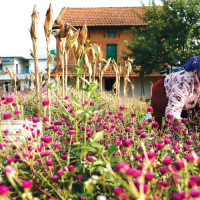- Wednesday, 29 October 2025
Maitidevi: A Sacred Temple
Nepal is a country of diverse ethnicity, language, and religion. Among many different religions, Hinduism is in its majority, and numerous Hindu temples and shrines exist throughout the country, and its concentration is in the Kathmandu valley. Maitidevi temple—also known as Pancha Kumari temple and one of the “Shakti” peeth"—is in central Kathmandu.
Structure
Maitidevi Temple with a pagoda-style brass-metal roof supported by wooden tudals that bear carvings of gods. The temple’s Gajur, also known as the pinnacle—the top centre-most structure on the roof, which has a small metal umbrella-like structure called Chatari. Guarding animal sculptures is another attractive feature of There are two stone guarding lions and four brass metal lions, standing on stone pedestals at four corners of the temple. In Maitidevi temple also, sculptures of lions guarding the temple can be seen. There are two stone guarding lions and four brass metal lions, standing on stone pedestals at four corners of the temple. Altogether, there are 13 metal lion sculptures and two stone lion sculptures. Similarly, bells are also important features of Hindu temples. Maitidevi temple has a total of nine bells.
The temple's three entrances are carved artistically. The entrance always has triangular wooden or metal carvings called tympanums, which have very artistic carvings of different deities and guarding animals and designs. From the gajur, there are four long metal belts that hang up to the entrance; they are known as pataka.
Inside temple
As we enter the temple from the main entrance, we can see the main place where the goddess is enshrined. Only a small stone deity, only about 7 inches tall and heavily decorated with various silver ornaments, is seen at the centre, which is believed to be the goddess Durga, and no sculptured idol of Durga can be seen. The stone idol is decorated by many silver decorative and protective sculptures; the main one is the silver sculpture of nine goddesses, situated above the main stone idol. There are also two sets of nags—or nine snakes—that protect the goddess. The place is also decorated with red frill cloths. Inside the temple, on the centre floor, we can see a silver circular mandapa, of diameter 25 inches, where materials of worship and offerings are kept prior to making the offering to the goddess.
Outside temple
In front of the temple there is a very old and large pipal tree, whose trunk circumference is approximately 10 m and is considered very holy. People worship the tree as a symbol of Lord Bishnu. This peepal tree is about a hundred years old and gives a harmonious green environment.
In front of the temple, there are four small Buddhist stone stupas, exhibiting harmonious coexistence of both Buddhist and Hindu culture. In the surrounding courtyard of the temple, there are small shrines that enshrine many gods and goddesses, such as Shiva-Parbati, Bishnu, Radha-Krishna, Ganesh, and Saraswoti.
Every morning large numbers of devotees visit the temple for worshipping, and on special days, such as each Saturday, Ekadashi, Purnina, Aunsi, Teej, and other holy religious days, the numbers of devotees increase considerably. The temple is very popular during Dashain and Tihar.
Conclusion
In Nepal, there are many such temples that hold strong cultural meanings and beliefs for the Hindu people. As citizens, we should be able to preserve these cultures, as they are our country’s wealth. Presently, there is a lot of consciousness among citizens that we should preserve our holy places and cultures for many coming generations.
Grade: VIII, St. Mary’s High School, Jawalakhel, Lalitpur









-original-thumb.jpg)







